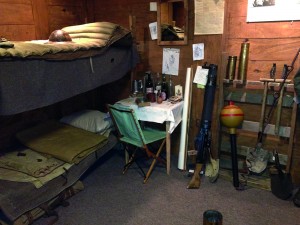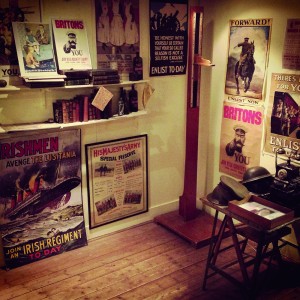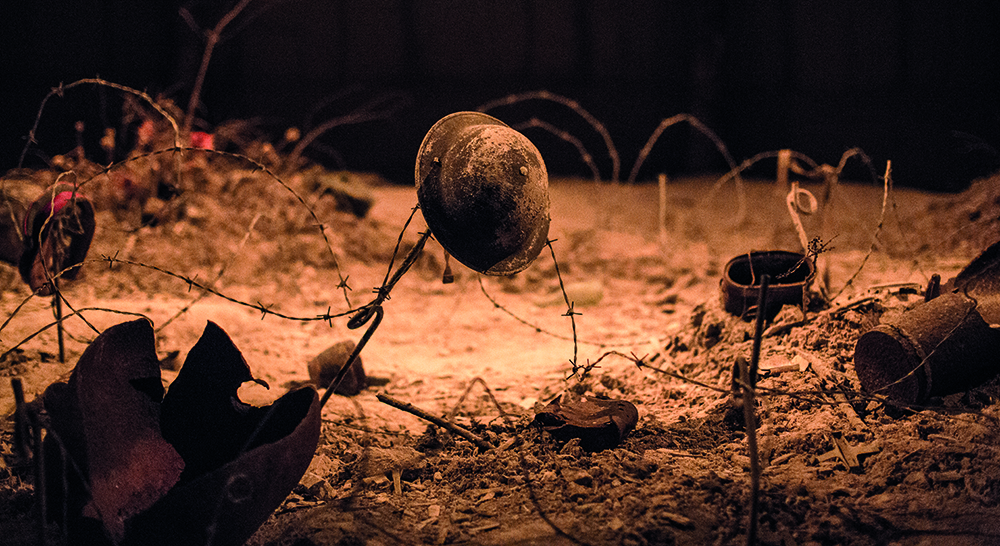Museum
Published in Issue 4 (July/August 2014), Reviews, Volume 22Situated in a purpose-designed building, the Somme Heritage Centre is dedicated to Ireland and the First World War. Although located in a place with a strong unionist heritage, the centre is not solely devoted to the 36th (Ulster) Division, although naturally it features strongly. The centre itself is undergoing some important structural and administrative changes and will soon be designated a museum.

A reconstructed dugout
The exhibition, as it were, begins right at reception, where uniforms, posters and other artefacts are on display. The main exhibition hall is currently hosting ‘Ireland on the Brink of War’, which looks at events from the Home Rule crisis to the outbreak of the world war. It is relatively ambitious, with items borrowed from institutions throughout Ireland, including the National Museum of Ireland and the Ulster Museum.

Some of the posters on display.
Some of the posters on display.[/caption]It is well laid out, with panels numbered from 1 to 20 which take the visitor from the beginning of the crisis to the outbreak of war, with particular focus on individuals such as Edward Carson and John Redmond, and organisations like the Ulster Volunteer Force and the Irish Volunteers (wrongly referred to as the ‘IVF’). It is a comprehensive and balanced account, explaining the hopes and fears on both sides and how opposition to Home Rule took on a militant character, which provoked a similar reaction from the other side.
The exhibits themselves consist of the expected weapons, badges and other artefacts. Catching the eye at one end of the room are two enlarged Punch cartoons, neither flattering to Redmond. At the other end is an equally eye-catching banner of the Irish Volunteers emblazoned with ‘Éire Go Bragh’ and a depiction of Kathleen Ni Houlihan. Elsewhere there are mannequins wearing uniforms of the Ulster and Irish Volunteers. There is also one mannequin of a member of the Women’s Social and Political Union, popularly known as the Suffragettes—a reminder that there were more than two kinds of militants threatening violence in Ireland at this time.
While there is not much in the way of hi-tech gadgetry, there is an interactive video and, more interestingly, a headset through which you can listen to first-hand accounts of people involved in the events of these years. Look out for the section on Paul Wentzel, a resident of Bangor, Co. Down, who was put on trial for being a German spy at the outbreak of the war. Found not guilty, he was detained on the Isle of Man as an enemy alien. The exhibition neatly segues into the world war itself, with a display cabinet of German weapons, flags and insignia.

‘No man’s land
You pass through the main hall to get to the permanent exhibition. It is worth stopping here to look at the memorial plaques from churches commemorating members lost in the war. Display cabinets hold artefacts dug up from Thiepval Wood—medals, helmets and even soil from the battlefields where the Ulster and Irish divisions fought. A video running on a loop looks at the war from a local perspective.
Entry to the permanent exhibition is by guided tour only. Trevor, our guide, gave us an interesting, entertaining and informative talk as he took us through. This consists of the recreation of a ‘typical’ Ulster town at the outbreak of war, complete with a preacher exhorting the sons of Ulster to fight the Hun. This leads on to the enlisting and training of soldiers before being sent to the front.
From here on things get pretty grim. Trevor explained how a trench was excavated, fortified and made habitable by the soldiers. Then we were led through the reconstruction of a section of trench. This is wider than the real thing would have been and floored in concrete rather than mud. Nevertheless, it was an unnerving experience, as we learned about the rigours of trench life, what it was like to be shot at and shelled, and how ordinary standards of hygiene and comfort were impossible to maintain. The soldiers were in more danger from disease, rats and trench foot than from the enemy, it seemed.
This is all recreated in realistic detail, with mannequins in authentic uniform and equipment on sentry duty, making do in a dugout, or waiting to be stretchered to the rear. The whole effect is further enhanced by a soundtrack of rifle shots and artillery bombardment, accompanied by flashes that briefly lit up the gloom.
We emerged from the trench onto a stretch of no man’s land. Here we sat down to view a film projected onto five large screens that told the story of the Battle of the Somme. This was very effective, with different images and captions on the screens complemented by a soundtrack of first-hand accounts from soldiers of all ranks in the Ulster and Irish divisions who took part in the four-and-a-half-month-long battle.
After the trench experience, it was a relief to sit in the new café and have a break. The centre is certainly worth a visit. It is informative and engaging and presents a relatively unvarnished view of the First World War and what it was like for those who went through it.
















